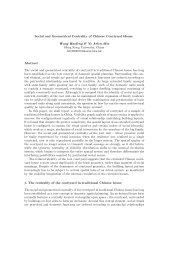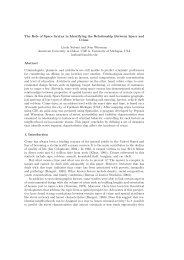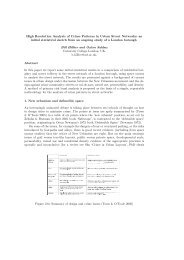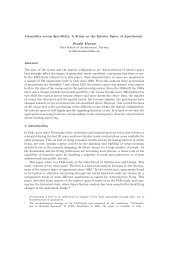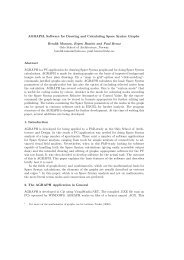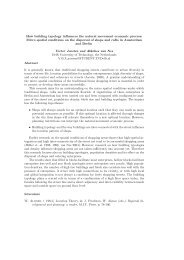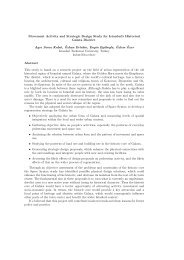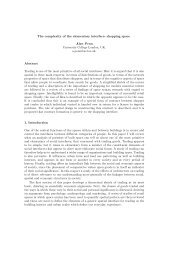The spatial behavior of residential burglars Manuel J.J. ... - TU Delft
The spatial behavior of residential burglars Manuel J.J. ... - TU Delft
The spatial behavior of residential burglars Manuel J.J. ... - TU Delft
Create successful ePaper yourself
Turn your PDF publications into a flip-book with our unique Google optimized e-Paper software.
434 <strong>Manuel</strong> J.J. López<br />
these suggestions are not supported by our data.<br />
• 2. Can we use the findings <strong>of</strong> this study and make a geographical application that<br />
the police can use to improve the efficiency <strong>of</strong> criminal investigations and catch<br />
criminals more rapidly? Yes we can. <strong>The</strong>re are several techniques to establish the<br />
geographic pr<strong>of</strong>ile <strong>of</strong> an <strong>of</strong>fender. Some techniques are extremely simple while others<br />
are so complex that they require the utilization <strong>of</strong> specialized computer s<strong>of</strong>tware.<br />
However, more complex is not always better. <strong>The</strong> current research shows that the<br />
simplest technique that establishes the geographic pr<strong>of</strong>ile <strong>of</strong> an <strong>of</strong>fender (the circle<br />
technique) is preferable to more complex ones. Presently, there are several commercial<br />
computer systems that produce maps that indicate the most probable area<br />
<strong>of</strong> <strong>of</strong>fender residence. <strong>The</strong>se systems require considerable financial investment and<br />
police <strong>of</strong>ficers must receive specialized training before they are able and allowed to<br />
use the computer s<strong>of</strong>tware. It is doubtful whether the commercial computer systems<br />
<strong>of</strong>fer any added value. Models that try to improve the results <strong>of</strong> the circle technique<br />
(e.g., by taking into account one or more distance decay functions, a buffer zone<br />
and/or a specific travel direction) are not likely to improve the result <strong>of</strong> geographic<br />
pr<strong>of</strong>iling. 8<br />
This presentation was limited to the parameters that are related to the awareness<br />
space <strong>of</strong> the criminal <strong>of</strong>fender. <strong>The</strong> influence <strong>of</strong> the opportunity space was left out <strong>of</strong> the<br />
equation and spared for the presentation <strong>of</strong> Akkelies van Nes. We did so because the<br />
presentation <strong>of</strong> van Nes will show that the <strong>spatial</strong> and physical characteristics <strong>of</strong> the built<br />
environment (opportunity space) have an important influence on the criminal <strong>behavior</strong> <strong>of</strong><br />
<strong>of</strong>fenders. Offenders, like <strong>residential</strong> <strong>burglars</strong>, know their territory well and can indeed be<br />
defined as “space explorers” (Hillier 1996). Can this help us and aid us in our quest for<br />
better and more powerful techniques <strong>of</strong> geographic pr<strong>of</strong>iling? I am convinced that it can.<br />
However, let us first listen to van Nes to gain an understanding <strong>of</strong> the precise relationship<br />
between criminal opportunity and the <strong>spatial</strong> characteristics <strong>of</strong> the built environment.<br />
Literature<br />
Barker M., (2000) <strong>The</strong> criminal range <strong>of</strong> small-town <strong>burglars</strong>, in: D. Canter en L.<br />
Alison, Pr<strong>of</strong>iling property crimes, Liverpool: Ashgate Dartmouth, p. 57-73<br />
Brantingham, P. and Brantingham, P. (1981) Environmental Criminology, Sage<br />
Publications, Bevery Hills, Sage.<br />
Brantingham, P. and Brantingham, P. (1984) Patterns in Crime, Macmillan Publishing<br />
Company, New York.<br />
Brantingham, P.L. en P.J. Brantingham, (1993) Nodes, paths and edges: considerations<br />
on the complexity <strong>of</strong> crime and the physical environment, in: Journal <strong>of</strong><br />
Environmental Psychology, nr. 13, p. 3-28<br />
Brantingham, P.L. en P.J. Brantingham, (1995) Criminality <strong>of</strong> place: crime generators<br />
and crime attractors, European Journal on Criminal Policy and Research,<br />
Vol. 3, nr. 3, p. 5-26.<br />
8 See also the study <strong>of</strong> Snook (2000) in which students were informed about the principles <strong>of</strong> distance<br />
decay and the range <strong>of</strong> operation. Students were able to define search areas on a map that were as<br />
accurate as the computer program Dragnet.



